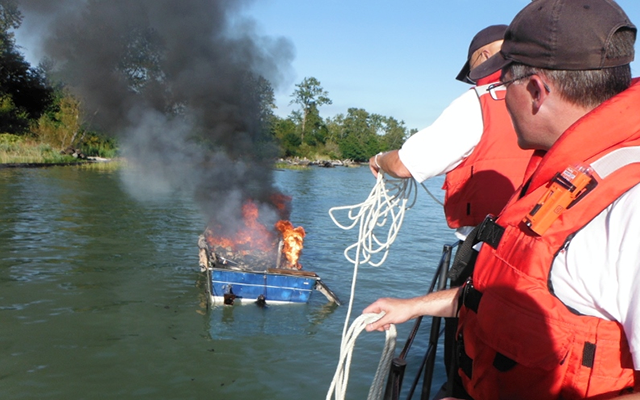A boat fire in Steveston that injured two people and nearly sent Shady Island up in flames Saturday evening underscored the need for agencies to coordinate marine fire rescue operations.
A 26-foot aluminium boat caught fire near Steveston Channel after its battery exploded, igniting the fuel line, said Kevin Gray, a deputy fire chief for the fire department.
It literally took a village to handle the rescue.
Two people, who sustained second-degree burns, were taken out of the Fraser River by a First Nations patrol boat; The Steveston Lifeboat, operated by volunteers from the Canadian Lifeboat Institution, then hooked the flame-engulfed boat to prevent it from drifting onto the tinder-dry island; Members of the Steveston Harbour Authority used their new boat — the SHARC (Steveston Harbour Authority Response Craft) — to douse the flames with its pumps; Shortly thereafter Richmond Fire Rescue (RFR) used a civilian boat to access the fire, with its portable water pumps, and assess the situation once the flames were out; Finally, when the boat sank, Port Metro Vancouver authorities determined it was not a threat to navigation or th envioronment.
“The people on that boat were very lucky that there were other boats around them to help,” said volunteer John Horton.
The lifeboat volunteers and harbour workers spotted the smoke from their respective docks in Steveston Village, during the Maritime Festival.
"Within 3-4 minutes we were on board our new emergency response vessel," said Joel Baziuk, the harbour's operations supervisor.
The SHARC is outfitted with two water pumps.
Baziuk said the harbour and the fire department have plans to create a standard operating procedure for marine fire rescues, using the SHARC, as the department does not have a boat of its own.
When the next boat fire happens in the area, and the agencies have reached an agreement, Baziuk said firefighters should be able to board the SHARC to operate the pumps.
But Baziuk said the SHARC was largely purchased by the harbour to protect its assets and in an ideal world, it not ought to be playing the role of firefighter.
“Arguably, it shouldn’t be our responsibility. …But obviously we’re not going to see a plume of smoke and not respond,” said Baziuk.
However, “in no way are we taking responsibility,” said Baziuk, adding that as marine traffic on the river increases over time, fire rescues “will be a problem one day."
Gray said marine training is underway for RFR firefighters, but there hasn’t been a need for an RFR boat.
“We’ve been able to manage without one,” he said, adding marine fires are still part of the department’s response area.
For fires outside the Steveston area (without the SHARC) the department will remain dependent on what Horton calls a “vessel of opportunity.”
Marine fires are presently fought by “anybody who can get there on the scene first,” said Horton.
Under the Canada Shipping Act and international law, boats are required to help.
Horton said he didn't know who is ultimately responsible for putting out boat fires.
Horton said the Canadian Coast Guard showed up at the scene with its hovercraft (stationed on Sea Island) after the boat fire was put out.
The Coast Guard coordinates joint rescue operations from its base in Victoria.
Lt. Paul Pendergast said they were in communication with the rescue boats.
He too said he doesn’t know who is ultimately responsible for such incidents.
“I don’t know the answer and it’s not an easy one to answer,” he said.
In an email, Port Metro Vancouver noted it's not a first responder, however, it co-chairs the Marine Emergency Response Coordination Committee with the Coast Guard, which aims to coordinate public and private agencies.
"Port Metro Vancouver maintains situational awareness and has more of a coordinating role within our jurisdiction, working with first responders, the community and different stakeholders," said spokesperson Jennifer Hunt.
The Port said the sunken boat posed no environmental risk (as the fuel had burned off) and its owner will be responsible for its removal.



